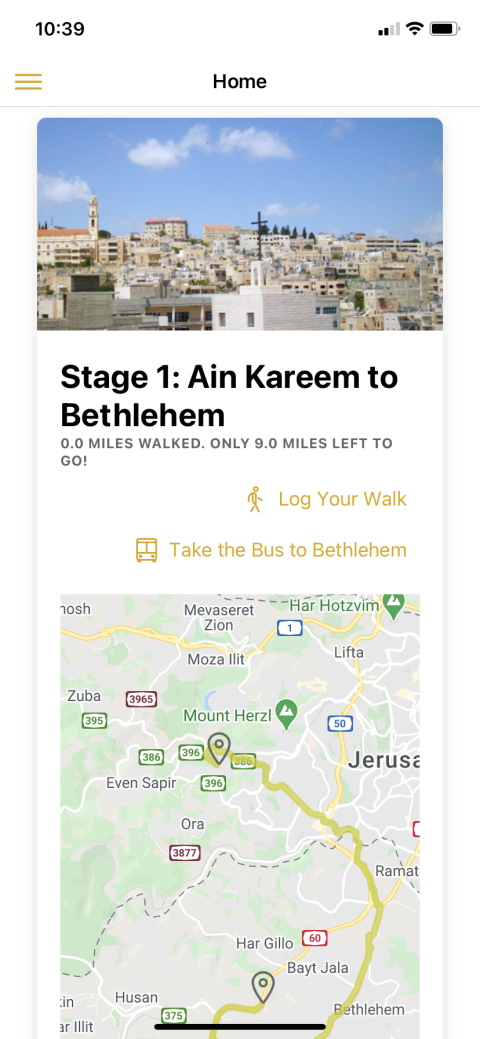Episcopal congregation builds Holy Land app for virtual pilgrimages

This winter, hundreds of Episcopalians embarked on a walking pilgrimage around the Holy Land without ever having to set foot outside their neighborhoods—thanks to an app built by St. Martin’s-in-the-Fields Episcopal Church in Columbia, South Carolina.
The church’s smartphone app, which launched on November 29, allows users to trace a virtual 98-mile path through and around Jerusalem that follows the story of the Gospel of Luke. As with a fitness tracker, the app logs your mileage whenever you walk—wherever you are in the world–and the app’s map shows equivalent distances covered in the Holy Land, divided into six segments.
Read our latest issue or browse back issues.
It isn’t exactly a substitute for an actual Holy Land pilgrimage, like the one that St. Martin’s-in-the-Fields clergy leaders had hoped to plan with their congregation. But with the coronavirus pandemic curbing international travel, this digital alternative has been widely embraced by phone-based pilgrims interested in learning about the land where Jesus once walked.
“It’s hard to know the stories, to be able to really go deep into the stories of the Gospel, without seeing the places where they happened,” said Susan Prinz, the church’s associate rector.
Prinz hatched the idea for the app in October with Caitlyn Darnell, a deacon who serves as the church’s director of formation and mission. To build it, they hired Greg Johnston, rector of St. John’s Episcopal Church in Charlestown, Massachusetts, who had previous experience in developing faith-based apps.
For much of the fall, Prinz and Darnell worked with Mitch Smith, rector of St. Martin’s-in-the-Fields, to create videos and other content that Johnston could use to flesh out the app. They also enlisted Episcopal and Anglican colleagues from around the world to contribute, including Jerusalem bishop coadjutor Hosam Naoum, who recorded a video welcome.
Prinz and Naoum knew each other from studying together at Virginia Theological Seminary, and Prinz had traveled to Israel twice, in 2012 and 2016. Those trips “made me see Jesus in a deeper way and experience his life in a way unlike anything I’d ever experienced before,” Prinz said. She approached the app with those experiences in mind.
Darnell hasn’t been to Israel, but in 2019 she walked part of the Camino de Santiago in Spain. Like the Camino, the virtual Holy Land pilgrimage can be completed at a pace of the pilgrim’s choosing. “You can start the pilgrimage at any time, and you walk it until you’re finished,” Darnell said.
Participation has expanded well beyond St. Martin’s-in-the-Fields. Through word of mouth and some online promotion, about 500 people registered in advance and received the church’s printed pilgrimage guidebook by mail. Some congregations around the United States joined St. Martin’s-in-the-Fields in taking up the app as their Advent activity, and Darnell said the virtual pilgrimage has attracted pilgrims from as far away as the Philippines.
Along the way, virtual pilgrims can learn about holy sites and landmarks by “unlocking” content produced and curated by the staff of St. Martin’s-in-the-Fields. They also get to know the various characters in Luke’s story.
“The general focus of the pilgrimage is very spiritual,” Darnell said. “Immerse yourself in the story of Christ. Put yourself in the story. Imagine where you are in the story. How does it relate to you? How will you grow spiritually? Who will you be on the other side of this?”
Darnell added that this pilgrimage can be completed even by people who can’t or choose not to walk the miles. They have the option of advancing to the destinations by completing devotional tasks to earn points, such as praying the Daily Office, doing an act of charity, or meditating in silence for 15 minutes.
The app ends with Jesus’ Transfiguration, thought to have occurred on Mount Tabor. Creating and soliciting more than 50 pieces of content for the app kept St. Martin’s-in-the-Fields leaders busy for about a month and a half, and they already are considering options for a second virtual pilgrimage for Lent, possibly following the Via Dolorosa in Jerusalem, Jesus’ final path to the crucifixion.
The app also can be used to host other types of pilgrimages, such as a tour of local landmarks of the civil rights movement.
“From the beginning, we said we’re offering this for the whole church. We want absolutely everybody to be a part of this with us,” Darnell said. “We’re all trying to make pandemic ministry work.” —Episcopal News Service





